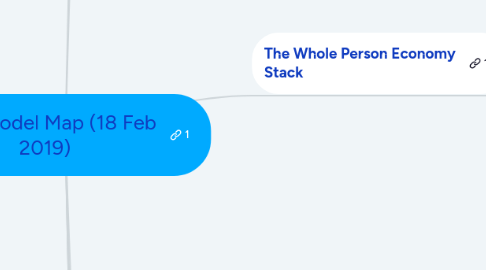
1. Introduction
1.1. What is the purpose of this document?
1.2. Background: Evan’s story / Whole Person’s Story
1.2.1. In pursuit of truth.
1.3. Executive summary
1.3.1. Problem and need
1.3.2. WPE hypothesis
1.3.3. Assumptions
1.3.4. The need for a just transition.
2. From Pipes to Living Systems
2.1. What is the purpose of an economy?
2.1.1. What is an economy?
2.1.2. Where are we and how did we get here?
2.1.2.1. Doug's breakdown and context-setting
2.1.2.1.1. Not only is the current state of economics not prepared to address the world's major challenges, it has caused and is contributing to their growth.
2.1.3. Why focus on economics to fix a broken world?
2.2. From "dismal science" to moral philosophy
2.2.1. From black and white to full-spectrum
2.2.1.1. The economy is part of society is part of the ecology
2.2.1.2. Economics has been focused on capital instead of people, and has a fundamental misunderstanding of people.
2.2.1.2.1. Economics needs a toolset for considering humans at the appropriate level of resolution.
2.2.1.2.2. 8 forms of capital
2.2.1.2.3. Nature is an asset, not income (Schumacher)
2.2.1.3. Scientism and mathiness hides what economics doesn't know.
2.2.1.4. Moving from market-obsession to a 4-component balance
2.2.1.4.1. Market
2.2.1.4.2. State
2.2.1.4.3. Commons
2.2.1.4.4. Household
2.2.1.5. Seeing clearly
2.2.1.5.1. Seeing clearly: People
2.2.1.5.2. Seeing clearly: System
2.2.1.5.3. Seeing clearly: Flows and relationships therein
2.2.2. Balancing "Is" and "Ought"
2.2.2.1. Positive Economics
2.2.2.2. Normative Economics
2.2.3. Economics is a multidisciplinary moral philosophy
2.2.3.1. From invisible hand to ethical foundation.
3. The Whole Person Economy Stack
3.1. COMPONENTS
3.1.1. RESULT
3.1.1.1. Experience
3.1.1.1.1. External sense experience
3.1.1.1.2. Felt experiences
3.1.1.1.3. Information that lacks subjective experience (qualia)
3.1.1.1.4. Spiritual
3.1.1.2. Impact
3.1.1.2.1. Environmental Ceiling
3.1.1.2.2. Social Foundation
3.1.2. ACTION
3.1.2.1. Behavior
3.1.2.1.1. Choice
3.1.2.1.2. Drivers
3.1.2.2. Practices
3.1.2.2.1. Concentration & Focus
3.1.2.2.2. Mindfulness
3.1.2.2.3. Self-regulation
3.1.2.2.4. Physical Health / Embodiment
3.1.3. FOUNDATION
3.1.3.1. Context
3.1.3.1.1. Information
3.1.3.1.2. Structures
3.1.3.2. Resources
3.1.3.2.1. Social Capital
3.1.3.2.2. Material Capital
3.1.3.2.3. Financial Capital
3.1.3.2.4. Living Capital
3.1.3.2.5. Intellectual Capital
3.1.3.2.6. Experiential Capital
3.1.3.2.7. Spiritual Capital
3.1.3.2.8. Cultural Capital
3.1.3.3. Desires
3.1.3.3.1. Freedom
3.1.3.3.2. Purpose
3.1.3.3.3. Pleasure
3.1.3.3.4. Livelihood
3.1.3.4. Ethics
3.1.3.4.1. Internal
3.1.3.4.2. External
3.2. FILTERS
3.2.1. Household
3.2.2. Commons
3.2.3. State
3.2.4. Market
3.3. INTERACTION LAYERS
3.3.1. ...
4. Case studies
4.1. Brazilian solidarity economy
4.1.1. Unicafes
4.2. Cooperation Jackson
4.3. Richmond COmmunity-Owned Development Enterprise
4.4. Just Banking
4.5. Buen Vivir Fund
4.6. Oodles of examples from Maker Cities
4.7. King Arthur Flour
4.8. Red Hook Wifi
4.9. Examples from Otto, Adam, Theory U
4.10. Household economics case study: Mudumalai Wildlife Sanctuary
5. Transition
5.1. A just transition
5.2. Intervention points
5.2.1. Culture
5.2.1.1. Cultural transformation
5.2.1.2. Alchemical process
5.2.2. Sectors
5.2.3. Disciplines
5.2.4. Interaction Layers
5.2.4.1. Individual
5.2.4.2. Interpersonal
5.2.4.3. Household
5.2.4.4. Community
5.2.4.5. Organizations
5.2.4.6. Culture, History, Legacy
5.2.4.6.1. Alchemical process
5.2.4.7. Macro and Mesa Economic Systems
5.2.4.8. Ecology
5.2.5. Technology
5.2.5.1. Open source
5.2.6. Policy
5.2.7. Leveraging Crisis
5.2.8. Processes / Frameworks
5.2.8.1. Behavioral Insights
5.2.8.2. Pedagogy / Education / Learning
5.2.8.3. Organizing / Movement building
5.3. The anatomy of a paradigm shift
5.3.1. Two loops
5.3.2. Structure of scientific revolution?
5.4. Key infrastructure
6. Toolkit for Participation & Integration
6.1. What are WPE practices anyone can start today?
6.1.1. Assess
6.1.2. Acknowledge
6.1.3. Repair
6.2. Engaging WPE (org) deeper
6.3. How to contribute to the WPE project
7. Conclusion, etc
8. xArchive
8.1. OLD-opportunuty
8.1.1. What is a Whole Person Economy?
8.1.2. At the systems level
8.1.2.1. Being multi disciplinary.
8.1.2.2. Balance between household, state and the commons
8.1.2.3. Putting ethics at the root.
8.1.2.4. Creating a container for values and ethics in economics
8.1.3. Intervention points
8.1.3.1. Macro-scale:
8.1.3.2. At the “whole person” level
8.1.3.2.1. What does it mean to be a whole person?
8.1.3.2.2. Expression
8.1.3.2.3. Tensions
8.1.3.3. What is the role of “Spirit”?
8.1.3.4. What does it mean to be a whole person in the context of participating in an economic system
8.1.3.5. Creating a container for values and ethics in economics
8.1.3.6. The role of technology
8.1.3.7. The Transition
8.2. Opportunity
8.2.1. Integrating them together
8.2.1.1. Discussion that threads the needle.
8.2.1.2. Intervention points
8.2.1.2.1. Small group work
8.2.1.2.2. Critical pedagogy
8.2.1.2.3. Community Participation
8.2.1.2.4. The role of spirit
8.2.1.2.5. Across sectors
8.3. The Transition
8.3.1. What is the role of historical context?
8.3.1.1. Entering a period of scarcity
8.3.1.2. Doug Carmichael’s view?
8.3.1.3. What did we have before the free-market economy?
8.3.2. Learning by doing
8.3.3. Inclusion through meeting people where they’re at
8.3.3.1. Integration through safe spaces
8.3.3.2. Feedback loops
8.3.4. The need for mindful, responsible, and ethical transition
8.3.5. The critical role of Key Infrastructure
8.3.6. What are Whole Person Economic Practices?
